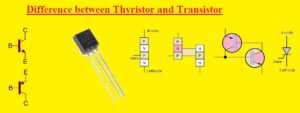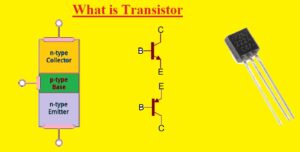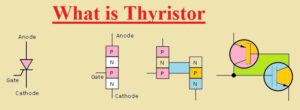 Hello, readers welcome to the new post. Today we will learn Difference between Thyristor and Transistor. The thyristor is a semiconductor component that is used for high volts high current and high power applications. While transistors is used for lower power circuits with that volt and current ratings of the transistor are also less.
Hello, readers welcome to the new post. Today we will learn Difference between Thyristor and Transistor. The thyristor is a semiconductor component that is used for high volts high current and high power applications. While transistors is used for lower power circuits with that volt and current ratings of the transistor are also less.
In this post, we will cover different parameters to find the differences between the transistor and thyristor. So let’s get started
Difference between Thyristor and Transistor
What is Transistor
- The transistor is 3 layer module that comes with two PN junctions. There are three pins it has.
- Transistors come in two types NPN and PNP. For PNP configuration there is one N region that is sandwiched between two P regions and for NPN P is a sandwich among the two N regions.
- Its pins are emitter-base and collector. Base work as control that on the transistor when supply connected.
- Transistors used amplifiers and switch in electronic circuits. There are three operating regions of the transistor function.
- Cut off region where transistor operates like an open switch, saturation region where it works as a closed switch and the third one is an active region where it used as an amplifier

What is Thyristor

- The thyristor is 4 layers semiconductor module. That has 3 Pn junctions.
- There are 3 pins it has that are anode-cathode and gate. The gate of this component is like the transistor that operates as a control pin.
- It is used for larger power circuits. It gets on through getting the current so preferred for larger power designs
- There are three guidance modes, it has reverse, forward, and forward guidance mode
It has three intersections. - It has three anode-cathode terminals and a gate.
- Used in phase fire control units
- Its power-handling capability is better than that of a diode.
- It required a higher value of voltage to operate than a diode.
- It is more expensive than a diode.
- This is heavy equipment.
Thyristor vs Transistor
- Transistor has 3 regions and three pins used in switch and amplifier circuits while thyristors has 4 layers and 3 pins used for rectifiers
- The structure of the transistor is such that N or P is sandwiched between two N or two P while thyristors have four P and N regions in an alternative fashion.
- Pins of the transistor are emitter-base and cathode and for thyristor are anode-cathode and gate
- There are two pn junctions for transistor and thyristors have 3
- There are 2 types of transistor NPN and PNP while thyristor has one PNPN
- There is no need for extra current to off the transistor and the thyristor needs
- Thyristors are used for high-power circuits and transistors are used for low-power circuits
- Turn on and off time for the transistor is small and the thyristor needs high
- The efficiency of the thyristor is high than transistor
- The transistor is a less expensive component
- Fewer volts drop for transistor than the thyristor
- The high value of current and volts ratings for thyristor than transistor
- Internal power losses for transistors are high
- Transistors are used for high-frequency applications than thyristors
That is all about the Difference between Thyristor and Transistor. All details have been explained to find the differences between transistors and thyristors.






